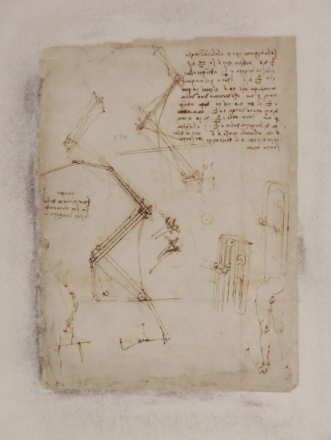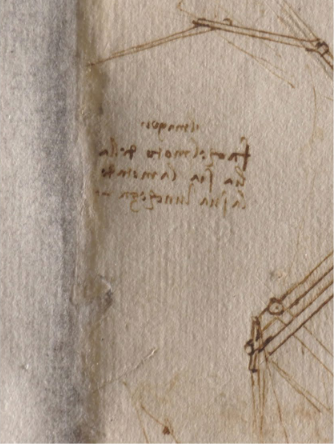ESRF X-Rays and Codex Atlanticus by Leonardo da Vinci
Users from the Historical Materials BAG reveal the composition of black stains on the passepartout of Codex Atlanticus Folio 843 by Leonardo da Vinci.
The Codex Atlanticus is one of the most extensive collections of Leonardo da Vinci’s drawings and writings (it collects materials from 1478 to 1519) and it is currently preserved at the Biblioteca Ambrosiana in Milan. The manuscript consists of 1119 folii framed with a modern passepartout, bound in 12 volumes: each page is composed of a passepartout that frames the original fragments (folii) by Leonardo.
The structure and the appearance of Folio 843 (figures above), were subjected to a careful visual examination together with Ambrosiana’s restorers and curators. Dark stains were localized in the left margin of passepartout and in some areas in the central part of the right and bottom margins, approximately 1 cm around the folio. No clear sign of staining was detected on Leonardo’s paper.
Therefore, methods of investigation were selected with the aim to:
♦ perform a rapid 1-day in-situ campaign of non-invasive investigations to compare the material differences of the passepartout margins and Leonardo’s folio;
♦ investigate chemical, mineralogical and physical nature of black stains of the passepartout in-depth and at microscopic level.
Several types of synchrotron radiation-based X-ray analyses were conducted by the scientists at the ESRF. X-ray fluorescence (XRF) mapping and X-ray absorption near edge spectroscopy (XANES) were performed at beamline ID21 while high angular resolution and high lateral resolution X-ray diffraction were carried out at ID22 and ID13 beamlines, respectively.
The Historical material BAG played an important role: thanks to this collaborative project, implemented with the support of Streamline, the cultural heritage user community has regular and easy access to these two diffraction beamlines. The set of complementary techniques revealed the unusual composition of the dark stain: black nano-particles of metacinnabar (b-HgS). Further research is needed to assess the chemical process leading to the metacinnabar formation in the controlled conservation condition of Leonardo’s Codex.
Edited by Chiara Facoetti

